With giant battling robots being one of the first images to spring into people’s minds when you mention anime to them, it’s no surprise that military science fiction was for years one of the most popular genres in Japanese animation. In fact there’s so many shows depicting some kind of futuristic—and usually mechanised—warfare that it can be hard to know where to start. Which is why I’ve picked out just four examples—from the action packed and epic through to the dark and philosophical—that I think most military SF buffs will find interesting.
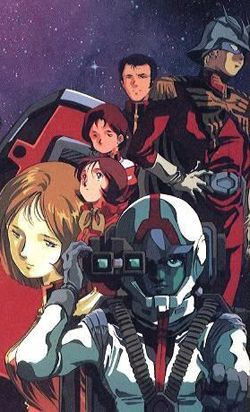
Mobile Suit Gundam
It’s not uncommon to hear people call Mobile Suit Gundam “Japan’s Star Wars,” and in many ways it’s a fair comparison. Both were launched upon an unsuspecting public in the late 70s, both have spawned decades of off-shoots and tie-ins, and both owe a sizeable chunk of their success and longevity to building industries from selling toys, video games and a seemingly never-ending range of assorted merchandise.
Both also share—on the surface at least—similar narratives; young boys struggle along the path of the hero against the backdrop of a decisive conflict. It’s here however that important differences in detail and tone become apparent. The odd personal conflict aside, there is no denying that Star Wars is very black and white in its goodies vs. baddies morality. Things are never quite as clear-cut in MSG, the show’s creator Yoshiyuki Tomino seemingly always striving for more moral depth and ambiguity. For a start the rebels this time are apparently the bad guys—the small Principality of Zeon’s struggle for independence seen as damaging to the stability of Earth. And while Skywalker and son were always too keen to jump into battle, MSG’s teenage hero Amuro Ray is often frightened and reluctant, querying his own ability and role in the war. Everything in MSG is fluid as our perspective shifts from character to character and faction to faction, with the result that it often becomes a discussion of the roles of violence and warfare in human society. It’s this that raises Mobile Suit Gundam above the mere space opera of Star Wars into the realms of real military SF.
That’s not to say it doesn’t have lots of cool geek-fodder too, though. You don’t sell millions of toys for over thirty years without some great designs; Gundam’s giant mecha fighting suits have become one of the iconic images of Japanese pop culture, and nothing beats watching them slug it out with oversized laser canons and great big swords. The animation in the original series (now best consumed in the form of three compilation movies) may look a little dated compared to some of it’s more recent spin-offs, but it has a freshness and energy that they often lack.
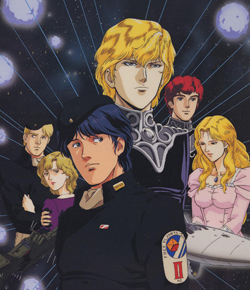
Legend of the Galactic Heroes
Based on a series of SF novels by Yoshiki Tanaka, Legend of the Galactic Heroes’ long adaption to animated form started in 1988, and soon became considered the pinnacle of anime’s military SF storytelling. Depicting the interstellar human civilisation of the 35th century, it tells the story of two warring factions through the eyes of two young, enigmatic commanders. On one side is the dictatorship of the Galactic Empire—based loosely on the history of 19th century Prussia—and the ruthless Reinheld Von Musel, and on the other the democratic Free Planets Alliance and the reluctant military genius and historian Yang Wen-li.
Like Mobile Suit Gundam it trades largely on moral ambiguity, but LotGH takes things a stage further by purposefully looking to analyse and contrast opposing political philosophies. Democracy is pitted against dictatorship, with both models having their strengths and weaknesses exposed and dissected. LotGH’s stroke of genius is in how it takes these heavy political concepts and deals with them through the actions and experiences of its two very likable protagonists. Although seemingly polar opposites on paper they both are slowly revealed to be incredibly similar, and dealing with the same conflicts of purpose and method. While Reinhard is often utterly ruthless in his quest for galactic dominance, he is similarly driven by a hatred for the corruption that class and privilege has brought to the Empire. Similarly Yang, a reluctant and foppish philosopher, is a formidable risk-taking strategist, that while prepared to put his and his men’s lives on the line for democracy is disgusted by the corruption, manipulation and opportunism he sees in the Alliance’s political system.
Not that LotGH is just philosophical debate—the true reason for the epically long series’ popularity amongst fans is that its elegant and non-stop story-telling is utterly enthralling. One minute you are watching massive space battles between fleets of thousands of fantastically designed ships, the next war-room clashes or conspiratorial political dealings. All are as engaging as each other.
All of which makes the fact that LotGH has never—and probably never will—received an official English translation or release especially tragic. There is however a brilliant fan-subbed version out there, which is well worth your time tracking down. Despite it’s 100 plus episodes it’s one of the most accessible and familiar feeling works to western SF fans, and a standout example of the space opera and military SF genres in any language.
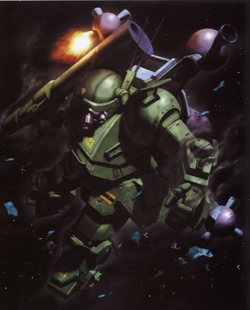
Armored Trooper VOTOMS
Giant robots and fantastically powered mecha had been a standard feature for decades in anime, but in 1983 Sunrise—the studio made famous by Gundam—decided to bring the genre slightly more down to Earth. It wasn’t the first time he had tried to merge hard SF and mecha, but creator Ryosuke Takahashi arguably got it right with Armored Trooper VOTOMS, a gloriously gritty story of nuts-and-bolts hardware and military betrayal.
VOTOMS opens with the galaxy settling into an uneasy peace after a century long war that has left whole worlds broken and decaying, their people struggling with failing technology and poverty. Our protagonist is a special forces mecha pilot named Chirico Cuvie, who stumbles across a secret whilst on a dubious mission, leading to betrayal from his own commanders and his branding as an outlaw. The series follows the once honoured hero as he goes on the run and attempts to find out the truth as to why he was betrayed.
What makes VOTOMS stand out against the mecha shows that preceded it is its depiction of technology—the galaxy has not only been very clearly ravaged by war, but it is struggling to keep its tech alive. The mecha themselves are some of the most convincing ever depicted, and the whole show has a gritty, junkyard aesthetic that sits comfortably amongst the best of the Mad Max and Alien movies—despite it’s interstellar setting it often feels like a tasty slice of 80s cyberpunk. For those of you that like your military SF hard and dark it’s certainly one to seek out.
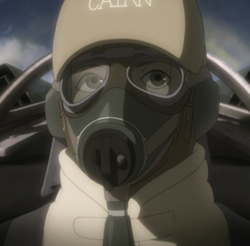
The Sky Crawlers
Now for something a little bit different.
It’s perhaps a little surprising that anime auteur and military hardware fetishist Mamoru Oshii (Ghost in The Shell, Patlabor) had never tackled outright warfare until he made The Sky Crawlers. What isn’t as surprising is that when he did, he took such a unique approach. Based on a series of novels by Japanese author Hiroshi Mori, The Sky Crawlers takes its time in revealing it’s true nature to the viewer. Oshii is famous for never rushing his narratives and giving his viewers time to indulge in his slowly paced cinematography, but tSC takes its time in revealing even it’s true setting. Much of the truth about what is happening in the world its characters inhabit isn’t made clear until its final act, and as such it makes it hard to elaborate without drifting into spoiler territory. Simply put, it is set at a time—possibly the future, or equally maybe an alternate past—when humanity has decided that the only way to avoid war is to stage an artificial, and seemingly endless, one. As a result an eternal air conflict is fought between two rival corporations using WWII style fighter planes and bombers, just to fill the war cravings of the global media, economy and watching public.
If eternal, staged war is the formula for survival, then one huge moral question faces the society that puts it into practice: who will do the fighting? For the tSC the answer is the “Kildren,” apparently genetically engineered clones of teenage children, raised to do nothing but fly and fight for the corporations that mass-produce them. It is through their eyes that we slowly learn not only about their world, but also the abusive psychological effect it has on them. Raised to know nothing but war, they fly routine, daily sorties while filling the gaps between with drinking and mindless, detached sex. In fact everything appears detached to them; their lives are so routine—the war so endless—that even the thrills of partying and combat seem to bore them. The fact that they are designed to never age—forever staying young, knowing that they will only, inevitably, die in battle—only compounding their increasing alienation from both each other and the world they are supposedly fighting for.
The movie is often slow and intentionally monotonous—forcing the viewer to sit through the frequently forgotten dreariness of military life, but the opening and regularly punctuating dogfight sequences are perhaps Oshii’s greatest trick. Not only do they break up the mesmerising monotony of watching the Kildren’s routine lives unfold, but they also make the audience participants in their world. The action sequences are so exhilarating, so beautifully choreographed that the viewer ends up almost craving them to return to the screen, and thus becomes the gawping, voyeuristic, war-demanding public of the Kildren’s world, and also the guilty abuser. It’s a masterstroke of manipulation, and a subtle one that perhaps doesn’t truly reveal itself until the films final, bloody dogfight. In terms of pacing and visuals The Sky Crawlers may seem out of place against the other examples of military SF here, but is actually more unique in what it has to say about violence and war.
When he’s not writing about anime Tim Maughan writes science fiction—his critically acclaimed book Paintwork is out now.










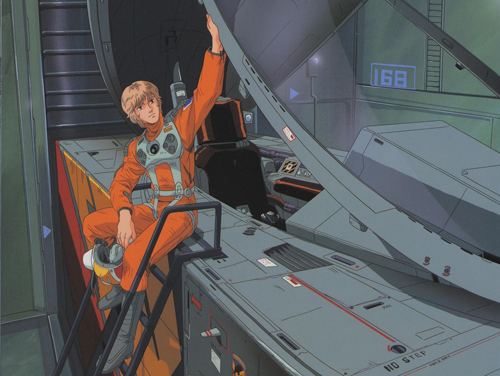
No Macross or Yamato? Or are they too space opera-y to make the cut? Macross Plus is Top Gun in space (with a hologram music idol).
IMO, the best parts of the Gundam franchise are the 08th MS Team (UC/0079) and Gundam oo (not UC). My favorite Gundam series is 0083 Stardust Memory, mainly because the villain is a badass who knows how to get sh*t done. (Because it’s my favorite doesn’t mean I think it’s the best.)
G Gundam is amazing for its sheer ludicrousness, though.
A couple years ago, a short series based on another set of novels by Yoshiki Tanaka came out, called Tytania. It’s got the same epicness as LOGH, except it’s only 13 or 14 episodes. And it’s in a much more modern art style…
(PS: Reinhard (not Reinheld) von Musel/Lohengramm, depending on when in the series you’re talking about. Once he takes posession of the Brunhild, he’s Lohengramm.)
@@@@@ccovington
Oh…I LOVE Macross Plus. You have no idea. One of my favourite, most treasured works of anime. But is it really Military SF…? Based around test pilots, until the end it doesn’t really show much in the way of either warfare or the military lifestyle.
But good lord how I love Macross Plus…I think I might have to write a piece for Tor on it actually, just so I have an excuse to watch it yet again…
I love Mac 7, for reasons I can’t explain. It starts slow, and it’s weird, but Fire Bomber. Frontier, though, that’s some damn good mecha anime. With all the references to original Macross* (and Ozma’s a Fire Bomber fan XD ). I don’t know if people count Macross as military. It’s got mecha and beam spam (and lots of the Itano Circus) and model kits, but it’s also about pop music and high school. The original Macross meanders a good bit, but the subsequent ones (excluding 7) meander less.
*When Ranka sings Ai o Oboteimasu ka during the climactic battle… ho boy. Chills.
I’d love to write about the 08th MS Team, which is all front line, all gritty, on Earth. And Shiro Amada kicks ass with a BALL in the opening scenes. BALL. A robotic ball with arms and a crappy gun. (Except the last episode, which is the two most annoying characters on a Journey. With ghosts.)
Last Exile should have made this list as well.
You’ve nailed most of my favorites already that don’t veer too far into space opera territory or generic action, although I’ve yet to watch Legend of the Galactic Heroes myself. It’s so long that it ever remains one of those things I eventually plan on getting around to, but never do.
I don’t really have much to add in this regard, although once again Code Geass jumps to mind as a likely prospect. Initially at least, it’s grounded with low-tier mecha and a focus on tactics, and is very heavily inspired by VOTOMs, which you spoke so highly of. Despite the fantasy-inspired elements of the Geass and witches, the technology and alternate history setting make it a fun take on military sci-fi.
Gasaraki was about a military squad … and a corporate (I think) family and demons. It was pretty unusual.
The Americanized version of Super Dimension Fortress Macross (known to many of us as the first third of the ROBOTECH saga) certainly stands as one of the most enjoyable and memorable military-themed anime adventures of all time. I’m a bit surprised it’s not taking a well-deserved 5th spot on this list, though I understand tastes will differ.
All I can say is that part of what motivated me to join the US Army after 9/11, was remembering the Macross episodes, and how ordinary, peaceful men thrust into extraordinary circumstances — Rick Hunter — decided to do their part in uniform.
Yes, it was just a story. By many standards, a story for children. But it’s been memorable for so many years, and is a treasured piece of my personal movie archive.
To add: Max Sterling will always be my hero. He’s military, clean-cut, wears glasses, is a nerd, a genius ace in the cockpit, and got to marry an exotic, ferocious, beautiful woman. I never got to be an ace fighter pilot, but I got all the rest. (grin)
When I looked at that first picture I immediately recognized it as an X-wing fighter pilot uniform. My first thought was, “Who made Luke Skywalker into an anime character?”
@radynski: My first thought was, “YAY LOGH!”
My mind jumped to Star Wars too, although seeing that it was not an X-Wing I raised an eyebrow and wondered what I was looking at.
I’m surprised there is no Yamato as well. When I watched it on the UHF channel broadcasting the dub back in the 70s (as Star Blazers) it was the one show that stuck with me. Contrary to the Wikipedia article, the dub was much less of a hack job than most of the dubs of the time. I found it recently on Netflix streaming and was delighted to find that I still knew the words to the song.
Yukikaze.
That is all.
I second your choice of The Sky Crawler. I watched it over Christmas and while it takes a bit to get into once the setting and story start coming together you are taken back by the implications of the characters actions. It is a great anime in terms of story and visual delight.
I’d think that Crest/Banner of the Stars would have made the list as well.
Gunbuster? I’ve seen lots of comparisons to The Forever War on the Internet, but have yet to read it, but Tor’s review this week certainly sounds like time dilation in particular plays the same vital role. It can’t really settle on one genre, going through school, military training, space opera, action and getting rather close to documentary in the last episode. And unlike most of the war epic anime, only 6 episodes long. Together with one of the best battle scenes ever animated. Getting through the first couple of episodes is probably the largest obstacle, though.
There’s also Evangelion, which contains a pile of setup for it being a military SF, then goes completely off the rails…
@Mouldy_Squid
Yeah, Last Exile has some GREAT battle scenes between the flying ships that feel a bit like a steampunk Master and Commander. But sadly i’ve always found the rest of the show a little dull…sorry :(
@Chappers
Gunbuster is a good call, and yes the Forever War influence is very strong. See also Shinkai’s Voices of a Distant Star – both take a lot of inspiration from FW with their themes of seperation, time dilation and mecha suits.
For the longest time it was rare to run into people who had heard of, let alone seen Legend of the Galactic Heroes. Glad to see it make the list.
What a journey it was. I got captivated by it on my first few episodes. (Being a space opera junkie I considered myself lucky to even find such a show existed. Or even could exist).
We needed more shows like the ones listed here in the United States. We are lucky in that we got stuff like Space Above and Beyond, Babylon 5, Battlestar Galactica though. I wish there was market for more stuff like Gundam and Legend. There is still a sector of the kingdom filled with people who are not willing to accept an animated medium for such story telling. Shame.
Soukyuu no Fafner, a series that even though it is similar to Evangelion in its basic concept, handles its “war” differently. Contrary to most other shows, the adults in the series want to make the children’s lives as normal and happy as possible.